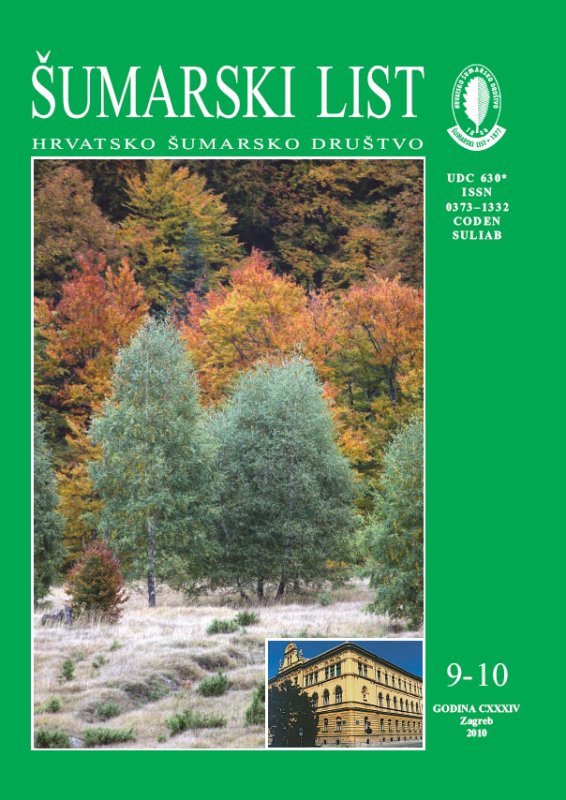
broj: 9-10/2010
pdf (7,71 MB) |
|
||||||||||||||
| RIJEČ GLAVNOGA UREDNIKA | ||
| Branimir Prpić | ||
| THE NEW FOREST LAW pdf HR EN | 445 | |
| IZVORNI ZNANSTVENI ČLANCI | ||
| Pandža,M., V.Krpina | UDK 630* 187 + 188 (001) | |
| Forest Vegetation of the Island of Vrgada and its Islets (Dalmatia, Croatia) pdf HR EN | 447 | |
| Pejnović,D., K.Krapinec, M.Slamar | UDK 630* 156 (001) | |
| Hunters in Croatia as a Socio-Geographic Group and their Socio-Demographic Characteristics pdf HR EN | 461 | |
| Šerić Jelaska, L., A. Ješovnik, S. D. Jelaska, A. Pirnat, M. Kučinić, P. Durbešić | UDK 630* 114.6 + 411 (001) | |
| Variations of Carabid Beetle and Ant Assemblages, and their Morpho-ecological Traits within Natural Temperate Forests in Medvednica Nature Park pdf HR EN | 475 | |
| Čas, Miran | UDK 630* 156 (001) | |
| Disturbances and Predation on Capercaillie at Leks in Alps and Dinaric Mountains pdf HR EN | 487 | |
| PRETHODNO PRIOPĆENJE | ||
| Matošević, D., M. Pernek, B. Hrašovec | UDK 630* 453 | |
| First Record of Oriental Chestnut GallWasp (Dryocosmus kuriphilus) in Croatia pdf HR EN | 497 | |
| PREGLEDNI ČLANCI | ||
| Tomićević, J., M. A. Shannon, D. Vuletić | UDK 630* 903 + 907.1 | |
| Developing Local Capacity for Participatory Management of Protected Areas: The Case of Tara National Park pdf HR EN | 503 | |
| Summary:In this study the focus is on the role of local communities in the management of protected areas with the expectation that without the cooperation and assistance of local communities achieving biodiversity conservation in places where the land and resources are fundamental to supporting people’s livelihoods will be less successful than if the local people actively support this goal. Management capacity in protected areas depends upon the system of governance, the level of resources and local community support. The key question of interest at the global level are whether the responsible authorities have the capacity to manage their protected areas effectively, and whether desired outcomes are achieved on the ground. Measuring these dimensions is contextual; what is effective in one country or locale may be inappropriate in another. Thus, assessing management capacity is context specific. The potential declaration of Tara National Park located in Serbia as a Biosphere Reserve necessitated research to characterize the institutional context, the social and demographic situation of the communities within the Park boundaries. There is a growing recognition that the sustainable management of protected areas ultimately depends on the cooperation and support of the local people. In order to achieve sustainable conservation, state legislators and environmental planners should involve local people in the management of protected areas and need to identify and promote social processes that enable local communities to conserve and enhance biodiversity as a part of their livelihood system. Drawing upon research in Tara National Park, this paper analyzes the potential capacity of people living within Tara National Park to effectively participate in the management of the protected area by incorporating activities that promote biodiversity within their everyday livelihood strategies. The results demonstrate that sustaining or providing alternative livelihood strategies is necessary in order to halt the exploitation of protected areas by local people striving to survive. Key words: Participatory management; protected areas; local community; livelihoods; communicative action | ||


